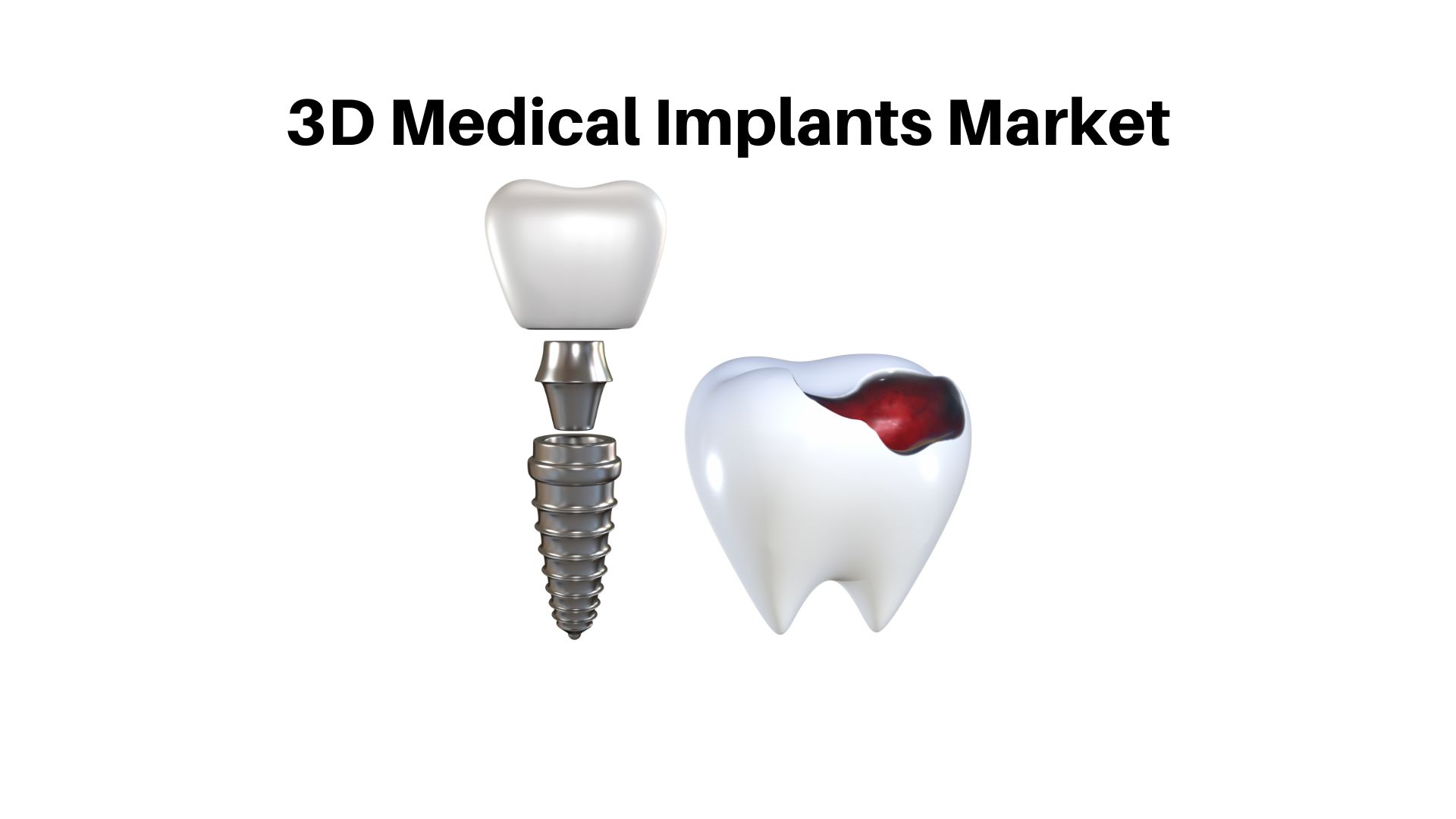3D Medical Implants Market Size USD 8.8 bn | Vendors Analysis (Ingenico, Verifone) By 2032

Page Contents
Market Overview
Published Via 11Press: In 2022, the 3D medical implants market was estimated to be worth USD 1.82 billion and reach its peak value of USD 8.8 billion by 2032 at a compound annual growth rate (CAGR) of 17.6% between 2022 and 2032.
The global 3D medical implants market is projected to experience substantial growth over the coming years due to increasing demand for personalized implants. 3D printing technology in medicine has revolutionized how implants are designed and produced, enabling customized implants that fit a patient's unique anatomy, leading to improved patient outcomes.
The 3D medical implants market is experiencing rapid expansion, expected to experience even greater expansion over the coming years. 3D printing technology is revolutionizing implant production, offering greater precision, faster production rates, and a wider selection of customization options.
The 3D medical implants market is experiencing tremendous growth due to an aging population and increasing prevalence of chronic diseases like cardiovascular disease and cancer, as well as advances in 3D printing technology and materials. Furthermore, digital healthcare solutions are expected to fuel market expansion further.
North America currently dominates the 3D medical implants market, with the United States accounting for the majority of sales. However, Asia Pacific is expected to experience the highest growth rate due to its rapidly developing healthcare infrastructure, rising healthcare spending, and large patient populations in countries such as China and India.
Drivers, trends, and challenges have an impact on market dynamics, which can impact businesses. Request for PDF sample report

Key Takeaways
- The global 3D medical implants market is projected to experience a compound annual growth rate (CAGR) of 17.6% between 2022 and 2032.
- This growth is being fuelled by an increasing prevalence of chronic diseases such as orthopedic, cardiovascular, and neurological disorders.
- The adoption of 3D printing technology in the medical industry is expected to present significant growth prospects for this market.
- North America is expected to dominate this space, followed by Europe and Asia Pacific.
Regional Snapshot
North America is expected to lead the 3D medical implants market due to its established healthcare infrastructure and increasing adoption of 3D printing technology in the region. Europe also sees significant growth due to chronic diseases increasing prevalence, driving demand for personalized medical implants. Asia Pacific will experience the fastest growth during the forecast period due to an aging geriatric population and rising chronic disease incidence there.
Drivers
- Technological Advancements: The rapid advancements in 3D printing technology have enabled the creation of complex medical implants with greater accuracy and efficiency, leading to an uptick in demand for 3D medical implants.
- Rising Incidence of Chronic Diseases: With an increasing prevalence of chronic illnesses like cardiovascular diseases, orthopedic disorders, and dental illnesses, there has been an uptick in demand for medical implants.
- Aging Population: With an aging population, demand for medical implants is expected to increase as more senior people experience health issues that necessitate these devices.
- Customization: 3D printing technology enables the creation of personalized medical implants, tailored to fit a patient's anatomy and improve their outcomes.
Restraints
- High cost: 3D medical implants tend to be more expensive than traditional implants, potentially restricting their adoption, especially in developing countries.
- Regulatory Challenges: The regulatory approval process for 3D medical implants can be complex and time-consuming, potentially delaying their availability to patients.
- Lack of Skilled Professionals: Crafting and installing 3D medical implants necessitate specialized skills and expertise, which may not be available in certain regions.
- Limited Material Options: 3D printing technology has enabled the production of more complex implants, but the materials that can be used for printing are currently limited – potentially restricting what types of implants can be created.
Opportunities
- Aging populations and an increasing prevalence of chronic diseases that require implants.
- 3D printing technology has allowed the creation of highly customized, precise implants.
- With its minimally invasive surgical techniques becoming more commonplace, there is a rising demand for dental and orthopedic implants.
- Key players in the market are investing increasingly in research and development.
Challenges
- High cost of 3D printing equipment and materials.
- Strict regulatory requirements and approval processes.
- Absence of skilled professionals in the field of 3D printing.
- Concerns regarding biocompatibility and safety of 3D-printed implants.
Recent Developments
- In 2020, Oxford Performance Materials received FDA approval for their OsteoFab Patient-Specific Cranial Device, a 3D-printed implant intended for neurosurgery use.
- In 2021, Stryker Corporation acquired OrthoSensor, an orthopedic implant sensor technology firm.
- Researchers from the University of British Columbia recently developed a 3D-printed spinal implant made from a biodegradable polymer that could potentially replace traditional metal implants.
Key Market Segments
Product Type
- Dental Implants
- Orthopedic Implants
- Cranio-Maxillofacial Implants
- Other Product Types
Technology
- Electron Beam Melting (EBM) Technology
- Laser Beam Melting (LBM) Technology
- Photopolymerization
- Other Technologies
Material Type
- Metals
- Ceramics
- Polymers
- Composites
Region
- North America
- Europe
- Asia-Pacific
- South America
- Middle East & Africa
Key Market Players
- Johnson & Johnson
- ЕОЅ GmbН, Stratasys Ltd
- Materialise, SLM Solutions Group AG
- Medprin Biotech GmbH
- Охfоrd Реrfоrmаnсе Маtеrіаlѕ Іnс
- МеdЅhаре Іnс.
- Kyocera Medical Technologies Inc.
- ВіоАrсhіtесtѕ
Report Scope
| Report Attribute | Details |
| The market size value in 2022 | USD 1.82 Bn |
| Revenue forecast by 2032 | USD 8.8 Bn |
| Growth Rate | CAGR Of 17.6% |
| Regions Covered | North America, Europe, Asia Pacific, Latin America, and Middle East & Africa, and Rest of the World |
| Historical Years | 2017-2022 |
| Base Year | 2022 |
| Estimated Year | 2023 |
| Short-Term Projection Year | 2028 |
| Long-Term Projected Year | 2032 |
Frequently Asked Questions
What are 3D medical implants?
A: 3D medical implants are implants manufactured using 3D printing technology and designed specifically to meet a patient's individual requirements. They utilize highly customized features and accuracy for maximum precision and functionality.
Q: What are the advantages of 3D medical implants?
A: 3D medical implants provide several advantages, such as increased precision and accuracy, shorter surgery times, and improved patient outcomes. They can be customized to fit a particular patient's anatomy which further increases implant stability while decreasing failure rates.
Q: Can 3D printing be used to manufacture medical implants?
A: Yes, various medical implants such as dental implants, orthopedic implants, cranial implants, and spinal implants can be crafted using this process.
Q: Are 3D medical implants secure?
A: 3D medical implants, when properly manufactured and utilized, tend to be secure. However, there have been concerns raised regarding their long-term safety and biocompatibility; more research is necessary for this area for assurance.
Q: How long does it take to manufacture a 3D medical implant?
A: The time it takes to manufacture an implant depends on various factors, such as its complexity and the 3D printing technology utilized. Generally, manufacturing of such medical implants takes anywhere from several hours to several days.
The team behind market.us, marketresearch.biz, market.biz and more. Our purpose is to keep our customers ahead of the game with regard to the markets. They may fluctuate up or down, but we will help you to stay ahead of the curve in these market fluctuations. Our consistent growth and ability to deliver in-depth analyses and market insight has engaged genuine market players. They have faith in us to offer the data and information they require to make balanced and decisive marketing decisions.



